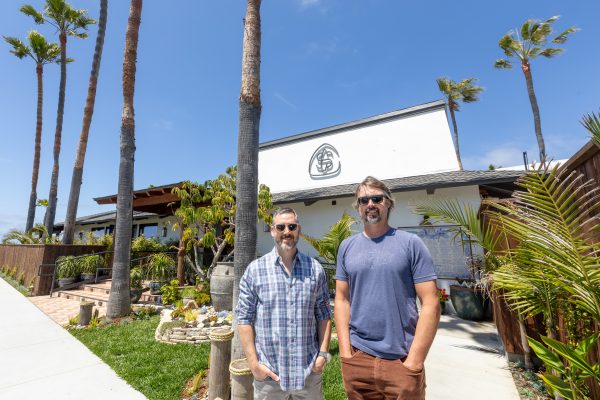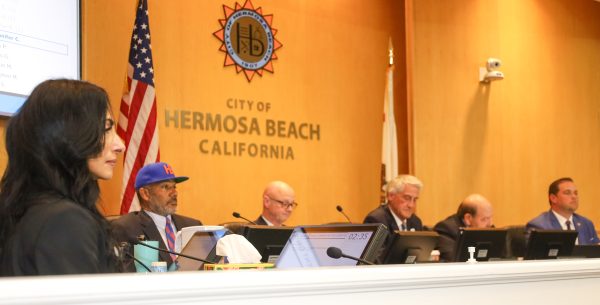
The Seaside Lagoon’s future became murkier Tuesday night in the wake of a City Council discussion that considered three options: filling the lagoon with sand for volleyball courts, filling it with sand along with a water play feature, or closing the facility entirely.
Council members stressed that their intention was to somehow keep the lagoon open. But Councilman Steve Diels suggested it might be necessary, in the short run, to close the lagoon’s water feature in order to keep it open in the long run.
“That is what we are trying to do – ensure the long term operation of the Seaside Lagoon, not close it,” Diels said.
The city appears to be at the end of a long struggle with the Los Angeles Regional Water Quality Control Board. The regulatory agency last year threatened more than $21 billion in fines for water quality violations under the Clean Water Act, but eventually issued only $51,000 in fines and issued a new permit intended to keep the lagoon open through 2013. But as part of that agreement, the city was required to undergo a new testing regime, one that became much more rigorous – and expensive – when the LARWQCB added an array of metals last fall.
The council has drawn a line in the sand regarding metals testing. Councilman Matt Kilroy said the new requirement – which seemed to derive from a rare metal exceedance last year – is beyond the bounds of reasonableness. He said absolutely nothing the city does in treating the water at the recreational facility could feasibly add metal content.
“One sample out of five years showed some significant metals,” said Kilroy, an engineer who has water testing experience. “In fact, the metal content was so significant it would end up as about $100 a day of silver being discharged in our harbor. It was obvious to anyone with any kind of common sense something had gone horribly wrong with the sample…It’s not even an outlier. It can’t be credible.”
Director of Recreation and Community Services Maggie Healy gave a report to the council outlining the costs the city has already incurred complying with the water board’s testing requirements. Since 2005, she said, the city has paid $361,700 in tests and current requirements will add $65,000 to that total this year. City Manager Bill Workman estimated that the “fully loaded” costs, including legal fees and staff time, were well over $500,000.
Councilman Steve Aspel called it “outright blackmail” that the city needed to put to an end.
“I refuse to be shaken down by some bureaucratic gurus of clean water,” Aspel said.
Healy also outlined current operational costs as well as those of the proposed three options. Last year, the Lagoon took in $370,000 in entry fees and event revenue and required an infusion of $280,000 in funds to meet expenditures of $650,000. To fill the lagoon with sand and add volleyball and beach tennis courts would require an initial outlay of $350,000 and an annual budget of $304,000; to fill the lagoon with sand and add playing courts as well as a water play feature would require an outlay of $750,000 and an annual budget of $425,000; and closing the lagoon altogether would require a budget of $146,000 this year and $70,000 the following year.
Councilman Pat Aust expressed surprise at the cost of adding sand. “That is a lot more money than I thought it would have cost,” he said.
As of now, the council still plans on opening the lagoon as normal this coming season – although it has also thus far given direction to staff to not conduct the metals testing.
City Attorney Mike Webb expressed concern.
“We are planning on opening, but planning on opening in violation of the new discharge permit,” Webb said. “And as city attorney, that concerns me.”
City staff meets with LARWQCB staff this Thursday. Webb said that according to the terms of the permit agreement, the city’s deadline to begin complying with the new tests is Feb. 7.
“I have no desire to shut down the Seaside Lagoon,” said Kilroy. “It is certainly not my first option…[But] I want there to be a light at the end of the tunnel. I do feel a light at the end of the tunnel – it’s a train coming from the opposite direction.”
Aust compared the water board to a drug addict.
“It’s like a crack addict – the more you give them, the more they want,” Aust said. “They are hooked on it — keep those checks coming. This is just crazy. We need to do something.”
Diels said that the lagoon should not be under the authority of the water board. He said the facility should not be held to the standards of the Clean Water Act since it is a unique operation that uses ocean water and discharges it, with only chlorinization and dechrlorinization adding or subtracting anything to or from the water. The city maintains that overall the water discharged is cleaner than the water pumped in from the harbor.
“We need to get out from under their thumb,” he said. “The writing is on the wall…What we are doing is taking ocean water, putting it in a sand pit, swimming in it, and putting it back in the ocean. That is it.”
Bill Brand expressed some optimism that the water control board might compromise. He noted that a year ago, after the council voted to shut the water feature down, the agency relented.
“This is too expensive,” Brand said. “But I’m optimistic. I mean, the board has been responsive, so I am more optimistic than my colleagues up here.”
The council will revisit the matter on Feb. 1. ER










